The Week in Estate Jewelry: Secret Messages, Butterflies, and Bat Wings
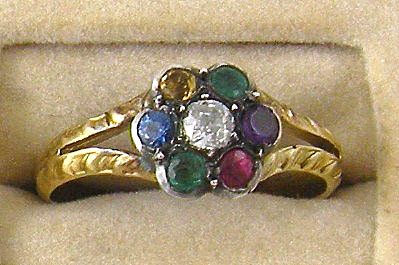
Monica McLaughlin used to write about jewelry full-time, but now she’s just an enthusiast who every so often shows us the amazing pieces she comes across.
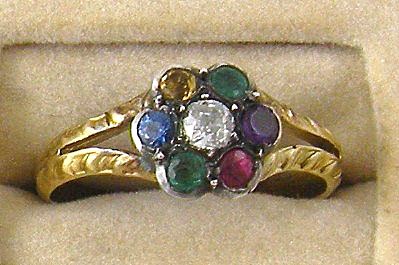
Yay, more coded jewelry! Those sentimental Victorians are at it again with this sweet little 18k ring. It looks like a flower, yes, but when you start with the center diamond and list the first letter of each stone clockwise from the top right (Diamond, Emerald, Amethyst, Ruby, Emerald, Sapphire, and Topaz), what do you spell? “Dearest.” Awww. Often you see these rings with the stones set in a straight line, so this flower pattern is particularly unusual and lovely. (The Victorians also used this same first-letter gem code to spell “Regard,” so keep any eye out for unusual color combinations; they may mean something!)
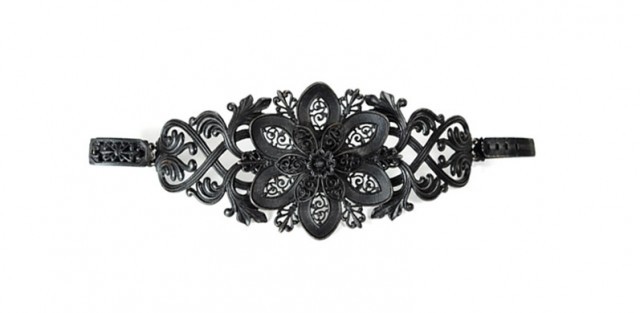
When you think of jewelry, iron just naturally springs to mind, no?
As the Napoleonic War moved across Europe, wealthy and patriotic citizens offered up their precious jewels to help their respective countries, and a new, intricate form of base metal jewelry took the place of the donated items. Called “Berlin Iron” after its place of origin, the jewelry was coated with black lacquer to prevent rust, and as the decades passed, the styles of the designs progressed from neoclassical to naturalistic. Berlin Iron was even exhibited at the 1861 Exhibition in London, and many pieces can now only be seen in museum collections.
This particular bracelet is a great, rare example. Probably French or German in origin, it dates to 1810–1820, and features an intricate floral motif with an adjustable clasp.
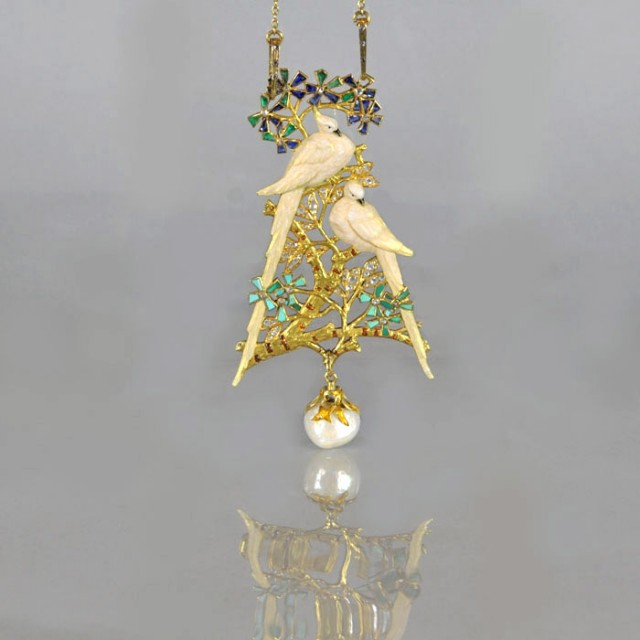
This beautiful Art Nouveau pendant is also very important. Designed by French jeweler Georges Fouquet in 1901, it depicts two lovebirds in iridescent enamel as they perch in a golden tree. Flowers of sapphire, emerald, turquoise, and diamond surround the birds, and a beautiful baroque pearl drop finishes off the composition.
Fouquet exhibited this piece at the 1901 Paris Exposition, but in later years it was thought to be lost, so it’s a very big deal (you know, relatively) to have it back on the market again. Wouldn’t be a bad investment piece if you’ve got a spare $160,000 — $400,000 lying around…
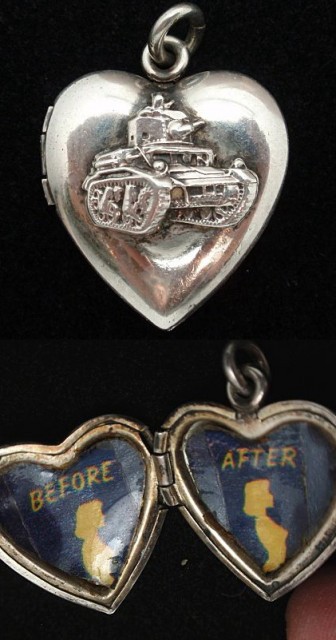
Now what girl wouldn’t like to get a nice tank locket from her man? During World Wars I and II, a trade sprang up in jewelry depicting the various branches of the military. Servicemen bought pieces abroad or even fashioned them by hand in the trenches, and sent them home to their wives, mothers, and girlfriends. These pieces became known as “sweetheart” jewelry, and they’re not too difficult to find. They’re usually pretty affordable, too, because (as in the case of Berlin Iron above) base metals were used in order to preserve the finer metals for the war effort. I recently found a lovely brass V-for-Victory Navy pendant for under $20 at a flea market. If you’re looking, keep an eye out for military crests and unusual images. (Like tanks.)
This Tank Corps locket dates to WWII, and the, um, interesting pictures on the inside aren’t original to the piece, but the dealer left them in to give the next owner “a chuckle.”
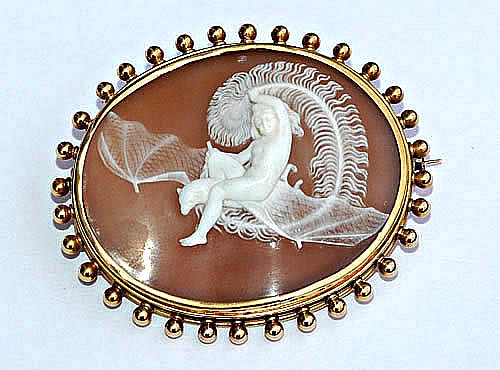
This is certainly not your typical cameo. Inspired by an early 19th-century painting by John Severn, it depicts Ariel, the sprite in Shakespeare’s The Tempest. Carved in shell and set in gold, the brooch doesn’t seem to be signed, but the workmanship is of incredible quality. Look at those wings!

Right now there’s a big Van Cleef & Arpels exhibition going on at the Cooper-Hewitt National Design Museum in New York, so if you like red-carpet jewelry, you should absolutely stop by. The Van Cleef & Arpels glam aesthetic is part of the 20th century style known as “retro.” Like all styles and periods, it has its rabid collectors, but it’s definitely an acquired taste. It’s a look better suited to Ladies of a Certain Age, maybe? But it does hold an important place in the jewelry timeline, and has a storied history that includes both Hollywood and actual royalty.
These emerald, diamond, and ruby earrings are typical Van Cleef, with quatrefoil emerald bead and brilliant-cut diamond tops, central flower clusters with diamond petals and emerald bead centers, and diamond-set drops with large emerald drops and ruby terminals. Subtle.
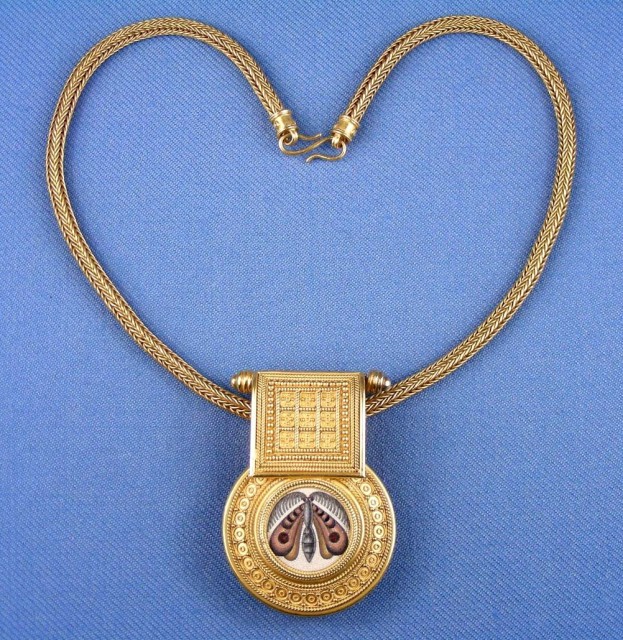
Last time, I promised to tell you about the Castellani family, and I’ll give you the short version here — but if you’re interested, please seek them out further, as their story is a fantastic conglomeration of buried treasure, hunting accidents, revolutionary plots, exile, and a multi-generational quest for technical brilliance (!).
In 1814, Fortunato Pio Castellani opened his first shop in Rome. In addition to being a skilled jeweler, Fortunato was an avid amateur archaeologist, and he was invited to observe and comment on some jewels recently unearthed from an Etruscan tomb in Cervetri, near Rome. He was fascinated by the ancient pieces, and immediately began to explore the techniques used by the Etruscan craftsmen. He then tried to replicate their designs, and succeeded to such an extent that he almost singlehandedly created the “archeological” jewelry craze that remained popular throughout the 19th century. This archaeological style features complicated designs with exacting detail. Pieces incorporate dangling amphorae shapes, intricate detailing, and — in a major jewelry-design development — granulation. Granulation is a metalsmithing technique in which tiny spheres of metal are fused to another metal surface without the use of solder or any other type of binder. The Etruscans were masters of gold granulation back in the 6th and 7th centuries B.C., but by the time the 19th century rolled around, the technique had been forgotten.
Fortunato’s sons Alessandro and Augusto eventually joined him in the jewelry trade. Alessandro became obsessed with granulation, and his desire to unravel the Etruscan secret became a 30-year quest. At one point he even discovered a small town in the Apennines, where peasant craftsman were creating jewelry that resembled the ancient style. (He promptly hired some of those artisans and brought them back to Rome.) Alessandro’s efforts paid off to a certain extent, and Castellani jewelry became renowned for its exquisite use of granulation — but their pieces always used solder. Augusto’s son Alfredo steered the jewelry firm into a successful third generation, but, sadly, the family never did figure out the secret.
This Castellani necklace was commissioned in 1872 to mark the engagement of Turin noblewoman Carina Gamba. The pendant, referred to as a “bulla” (a hollow pendant introduced by the Etruscans, and possibly used to hold a protective amulet), is hinged at the top and decorated with granulation and wirework. At the center is an extremely fine micromosaic of a moth, a symbol of the soul.

In 1924, Thomas L. Mott exhibited some striking new jewelry designs at the British Empire Exhibition in London. While the settings were largely simple and made of sterling silver, the color of the “stones” he used was anything but plain. That’s because they weren’t stones — Mott had set the wings of Morpho butterflies under crystal, and the crystal reflected their radiant blue up and out of the setting. While the wings of butterflies and moths had been used in jewelry for years, Mott’s designs became a sensation of the 1920s and ’30s. It also spawned competitors, and some pieces include reverse-painting of beach scenes and whatnot on the underside of the crystal. This particular brooch is hallmarked TLM, so it’s an authentic Mott.
(An interesting side note — the use of crystal overlays in jewelry continues today, and they’re used to particularly gorgeous effect in contemporary English jeweler Stephen Webster’s “Crystal Haze” collection. Instead of butterfly wings, Webster sets colored gemstones beneath the crystal, so that their color reflects up through the top stone in a warm, hazy glow. Beautiful stuff.)
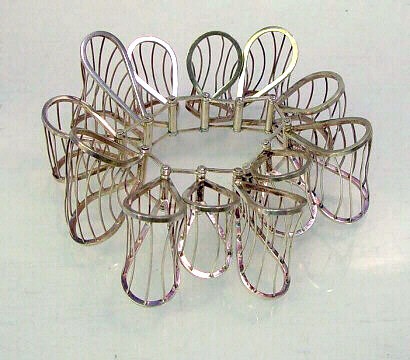
I’d occasionally like to use this space to highlight the work of contemporary designers, as amazing jewelry is always being made, but often does not reach many people. These pieces will become our antiques of the future, so it’s smart to keep an eye out for the new and unusual.
American designer Tina Rath has exhibited all over the world, and her work is currently in the collections of various museums. She is a master metalsmith; her pieces feature intricate construction and gorgeous juxtapositions of texture and unusual materials, including silk, fur, wood — even deer antlers. The construction of this sterling bracelet also incorporates movement; loops of silver move back and forth on handmade pins, so that the piece shifts around the wrist while wearing.
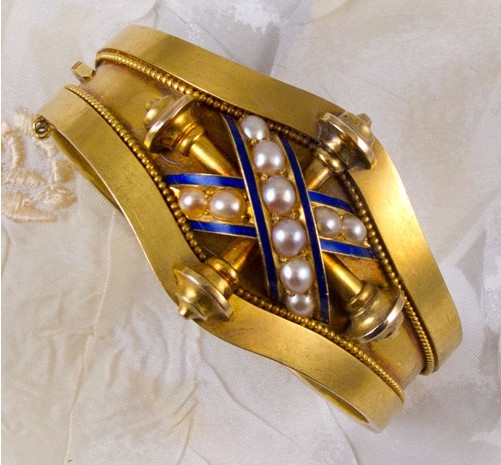
I’m loving this Victorian bangle. It’s solid 14k with pearls and cobalt blue enamel, and the quality of the workmanship leads the dealer to believe it was custom made by a master jeweler. It reminds me of Wonder Woman!
Previously: Owls, Tigers, and Snails.
Monica McLaughlin was born a century too late.